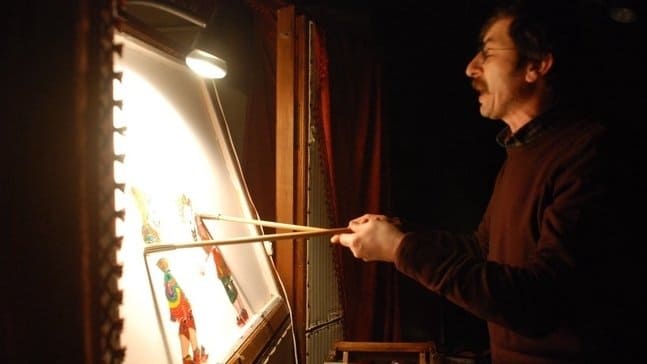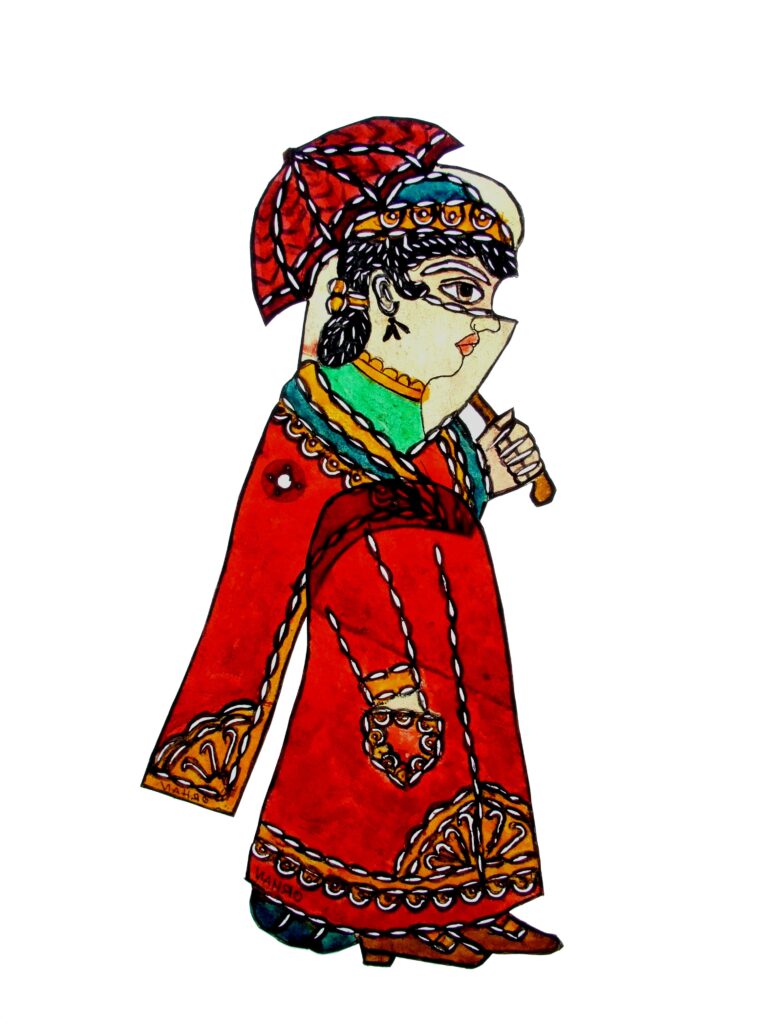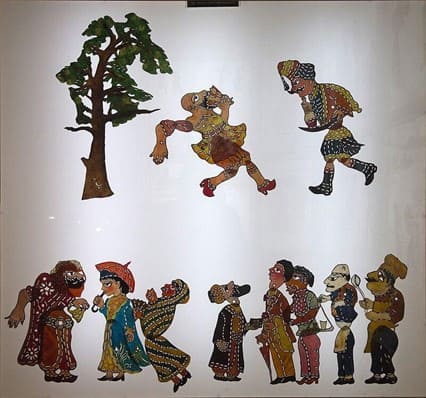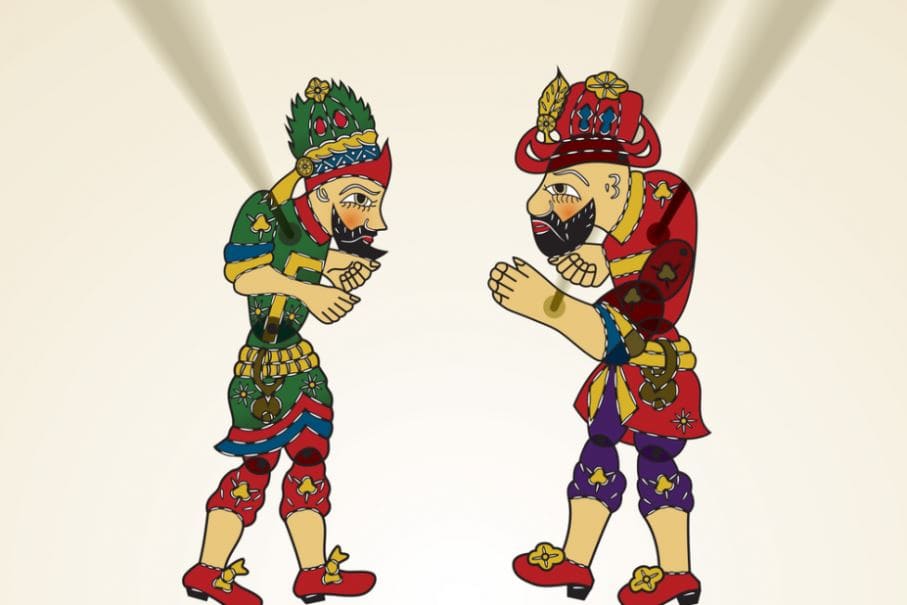Articles
Karagöz: Turkish theater
Article author: Olaia Maiza Sola
Date of publication of the article: 03/06/2025
Year of publication: 2025
Article theme: heritage.
According to the description provided by the UNESCO Convention for the Safeguarding of the Intangible Cultural Heritage, Karagöz is a type of shadow theatre in which figures of humans, animals, or objects known as tasvir are held in front of a light source, casting their shadows onto a screen made of ox or camel hide [1]. ] “The puppets are manipulated by a master of the art, the hayali, who is sometimes assisted by one or more apprentices learning the craft by helping create the tasvirs and providing musical accompaniment”. [2]. This form of theatre takes its name from one of its main characters, Karagöz (in Turkish: “Black Eyes” or “Gypsy”) [3].
It is a cultural expression that gained popularity during the Ottoman Empire, primarily in Türkiye, but it was also present in the regions that are now Syria, Egypt, Greece, Bosnia-Herzegovina, and Georgia.

The origin of Karagöz

There are several theories about the origin and arrival of this theatrical form in the Anatolian region [4].
The first and most widely accepted suggests that it may have originated in China and reached the Ottoman Empire through the Mongols and the Turkish migrations from Central Asia. According to other versions, these performances came from Egypt, after Sultan Selim I’s conquest in 1517. Another theory claims it was introduced to Anatolia by Gypsies from Java and India, since the arrival of Roma populations in the Ottoman Empire coincides with the period when Karagöz began to be performed. It could also have been brought by Sephardic Jews from the Iberian Peninsula.
Characteristics
These plays are comic in nature, led by the characters Karagöz and Hacivat, along with other supporting figures.
Its definitive form was standardized in the 16th century and is divided into a prologue (mukkademe, giriş), a dialogue (muhavere), the main play (fasıl, oyun), and the epilogue (bitiş), throughout which music plays an essential role.[5]
Through improvised dialogues and exchanges between characters, the plays present real-life situations and timeless reflections on the human condition. As a form of popular theatre, it represents the society of its time and reflects the social diversity of the people living in the empire, their beliefs, traditions, customs, languages, religions…
The Legend
According to legend, Hacivat and Karagöz were two stonemasons who worked together on the construction of the Orhan Gazi Mosque in Bursa in the mid-14th century, when the city was still the Ottoman capital prior to the conquest of Constantinople.
They formed a unique duo, and their endless conversations were so entertaining that the other workers often stopped working just to listen to them. When the sultan learned that they were the reason the mosque couldn’t be finished on time, he ordered them to be hanged.[6]

The Characters
The characters in this play are known for embodying various social categories, traits, and cultural aspects of the time. Hacivat represents the educated and sophisticated urban class, often portrayed as refined and elegant. He symbolizes the intellectual elite, including scholars, bureaucrats, and city dwellers. His speech is polished, and he is typically shown wearing traditional Ottoman clothing associated with learned individuals. By contrast, Karagöz represents the common people, particularly the lower classes, including rural populations and peasants. He is depicted as uneducated, witty, and humorous, often speaking in a more colloquial and direct manner. Karagöz usually wears simpler clothing, characteristic of the working class.
The characters in this play are known for embodying various social categories, traits, and cultural aspects of the time.
These two characters not only reflect the divide between urban and rural life but also highlight the tensions and interactions between different social strata of the Ottoman Empire. The performances frequently place these characters in humorous situations, emphasizing the dynamics and contrasts between their personalities and social backgrounds. In doing so, the show incorporates elements of the cultural, social, and linguistic diversity that existed during the Ottoman era. The interactions and conflicts between these characters often serve as a mirror of the complexities and pluralism of society at the time, as previously mentioned.
There are also some secondary characters worth analyzing, which may vary depending on the specific play.

First of all, Karagöz’s mother often embodies wisdom and traditional values. She can symbolize deeply rooted cultural norms, rituals, and customs of the time. Her character serves as a source of guidance or a voice of wisdom in the play, offering advice or insights grounded in those values. Another aspect represented by Karagöz’s mother is the importance of family and maternal influence. She personifies the nurturing and protective nature of a mother within the Ottoman social context, highlighting the significance of family bonds and the role of women in the household. This character may also function as a humorous element, by reproducing certain stereotypes associated with mothers or elderly women. Her appearances often include comic exaggerations meant to entertain the audience.
According to legend, Hacivat and Karagöz were two stonemasons who worked together on the construction of the Orhan Gazi Mosque in Bursa in the mid-14th century, when the city was still the Ottoman capital prior to the conquest of Constantinople.
On the other hand, Ays is often portrayed as a romantic interest. Her character symbolizes love, affection, or the search for romantic relationships within the narrative, leading to tension and comic situations among the various characters. She may also embody ideals of beauty, femininity, grace, or charm. This character often acts as a catalyst for conflict within the plot. Due to her particular social status and cultural background, she offers insight into the norms, values, or social expectations related to women in the Ottoman era.
Other recurring characters include the Balkan immigrant (Muhacir), the Tatar (Tatar), the Armenian (Ermeni), the Jew (Yahudi), or the Greek (Rum), among many others, who are portrayed as caricatures based on stereotypes [7].

The protagonists almost always meet a tragic end. The death of both characters can serve multiple purposes within the storyline. On one hand, it symbolizes the social issues, conflicts, and injustices of the time. It can also be seen as a reflection on power struggles and tensions between social classes, as well as the consequences of those conflicts. Such tragic endings are common in traditional literature, which often aims to impart moral lessons or highlight the harsh realities of life. Their purpose is didactic, although always wrapped in humor and satire.
Social Critique, Sufism, and Cultural Memory
Throughout history, this kind of cultural expression has been widespread among different peoples and civilizations. Theatre, puppetry, and humor are recurring means of releasing social pressure, while also carrying deep and complex sociopolitical critique [8]. Additionally, they served as a way for ordinary people to define themselves and express critical views against the wealthy classes. This is a phenomenon known as the “inversion of power dynamics”, whereby, for a brief period of time, social roles are reversed—though everything ultimately returns to its original state.
Shadow plays were typically performed in cafés, gardens, and public squares, particularly during Ramadan, fostering social cohesion in a festive, popular atmosphere set in public spaces.
Shadow plays were typically performed in cafés, gardens, and public squares, particularly during Ramadan, fostering social cohesion in a festive, popular atmosphere set in public spaces. It is worth noting the close ties between these performances and Sufism. While the primary goal of the play was entertainment, it also sought to offer a religious or spiritual experience. Although its origin is not explicitly Sufi, the stories and character interactions often resonate with Sufi teachings, conveying deeper philosophical messages through irony and humor. Even the duality between the two main characters, and the image of the shadows controlled by their master, are closely aligned with Sufi principles. This reflects the important role of Sufi practices in shaping Turkish society and culture.

Today, performances are held in theaters and schools, where they continue to attract a significant audience. In 2006, Turkish actor and producer Ezel Akay directed a film adaptation of one of the versions of Karagöz, titled Hacivat Karagöz Neden Öldürüldü – Killing the Shadows in its English release.
This cultural heritage, sometimes relegated to the background, is of great importance, as ir carries a system of values specific to a given society.
Moreover, in order to help safeguard these performances, numerous dissemination and mediation initiatives have been launched, along with protective measures implemented by both Turkish authorities and international institutions and organizations. Among these efforts are the inauguration of the Karagöz Museum in the city of Bursa, the establishment of research centers and institutes, and the promotion of its study in schools, ensuring generational continuity.
This cultural heritage, sometimes relegated to the background, is of great importance, as it carries a system of values specific to a given society. Furthermore, this art and technique belong to a society’s historical legacy, just like major archaeological sites and monuments, allowing us to understand other aspects of the historical context in which they developed.
References
[1] UNESCO. (2009). El Karagöz. Lista Representativa del Patrimonio Cultural Inmaterial de la Humanidad. https://ich.unesco.org/es/RL/el-karagoz-00180
[2] UNESCO. (2009). El Karagöz. Lista Representativa del Patrimonio Cultural Inmaterial de la Humanidad. https://ich.unesco.org/es/RL/el-karagoz-00180
[3] Encyclopædia Britannica. (s.f.). Karagöz. Recuperado el 29 de mayo de 2025, de https://www.britannica.com/art/Karagoz
[4] UNIMA Türkiye. (2021). Kâtip Salih. https://www.unima.org.tr/katip-salih/
[5] Union Internationale de la Marionnette. (2012). Karagöz. En World Encyclopedia of Puppetry Arts. https://wepa.unima.org/es/karagoz/
[6] Turkish American Arts Society of New York. (2016). About Us & Karagöz Everywhere. Karagöz Everywhere. https://karagozeverywhere.com/about-us
[7] Nicolas, M. (2012). Karagöz. Enciclopedia Mundial de las Artes de la Marioneta. UNIMA. https://wepa.unima.org/es/karagoz/
[8] Miller, A. R. (2013). Turkish shadow puppetry and the carnivalesque. Palgrave Macmillan.


